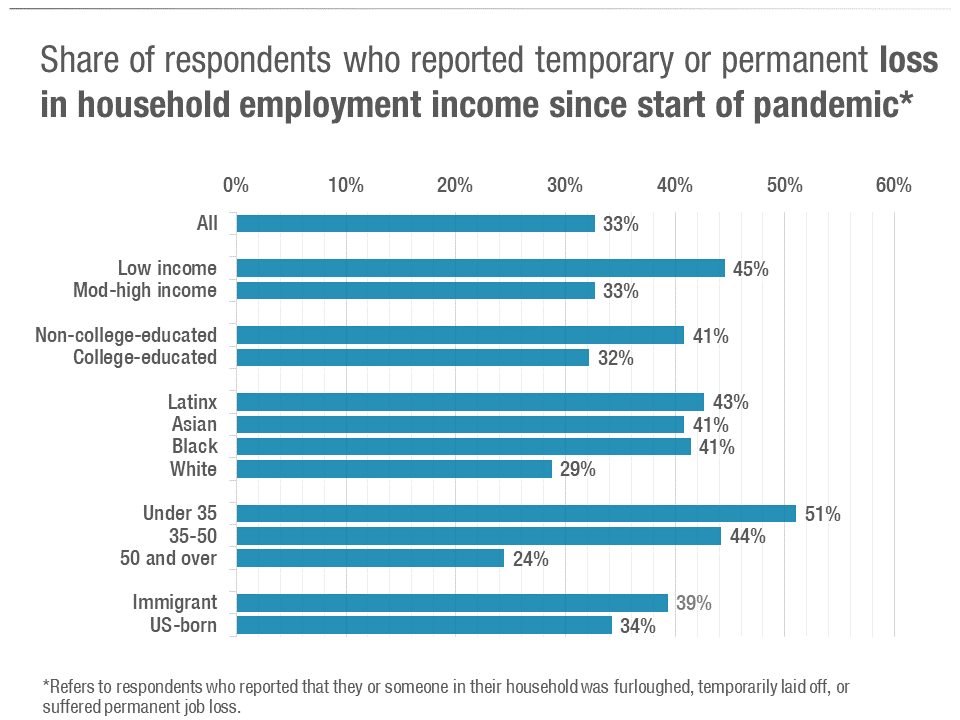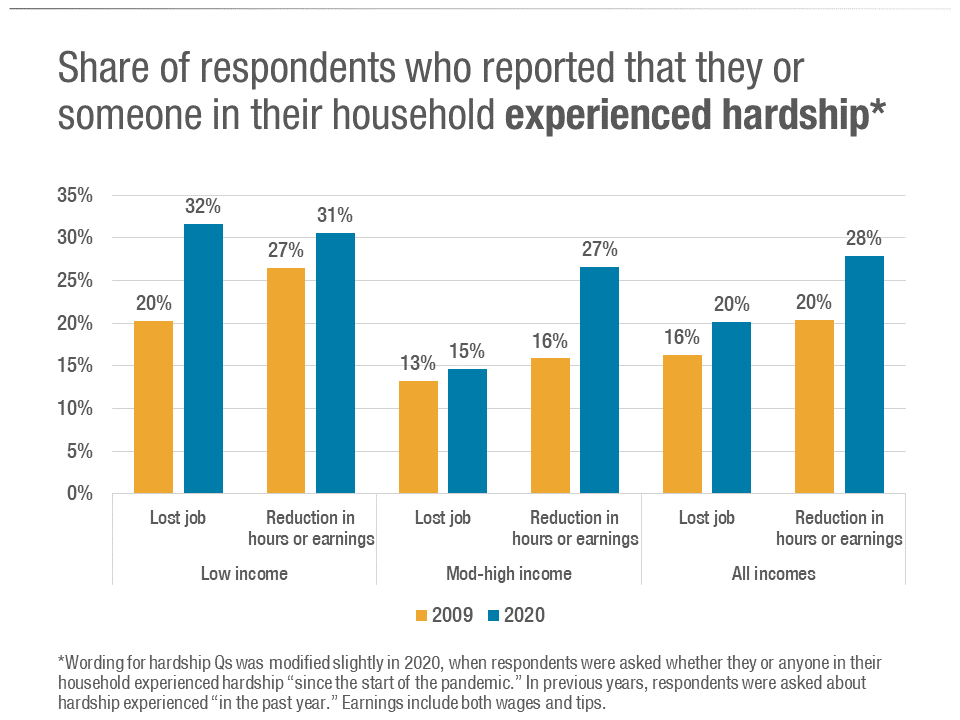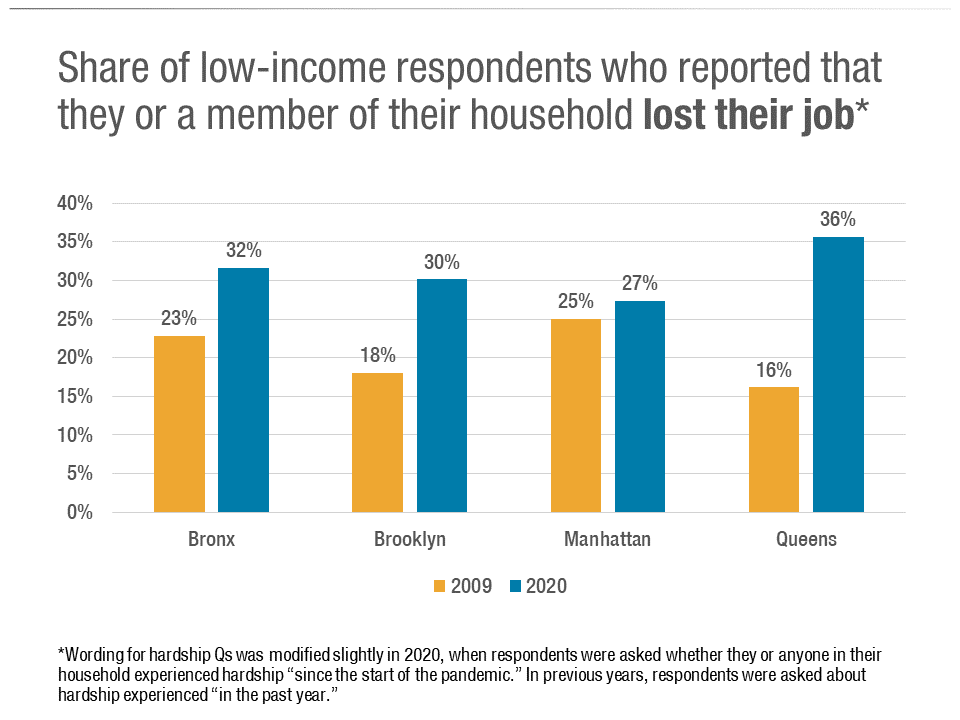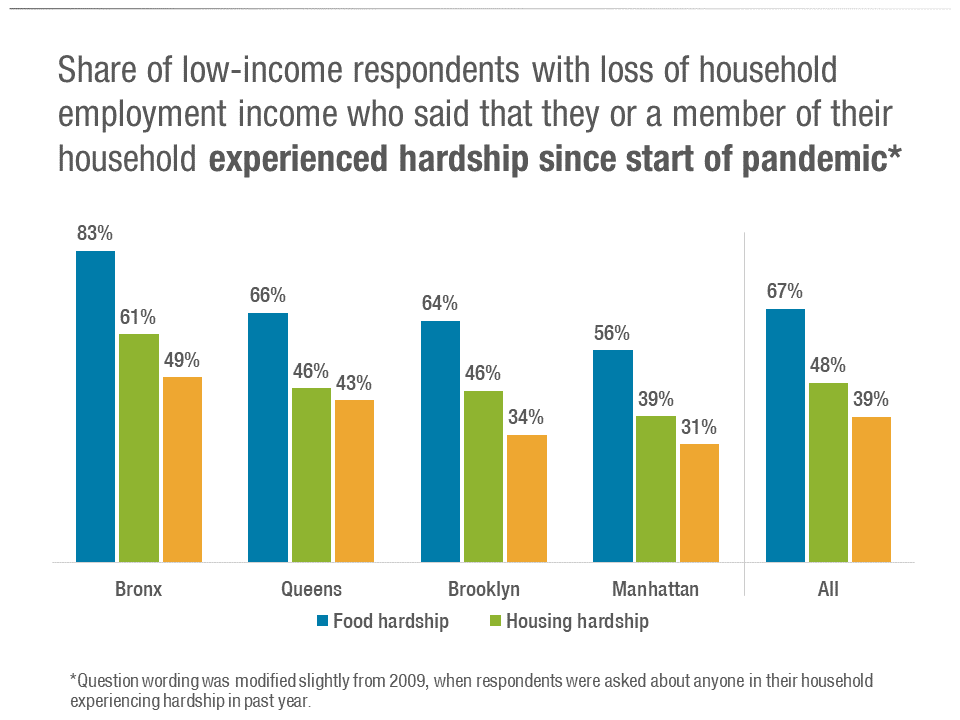The Pandemic Economy: COVID-19 Fallout Continues to Hit Low-Income New Yorkers the Hardest
Irene Lew
The COVID-19 economic downturn is considered to be the most unequal recession in U.S. history, with low-wage workers and people of color disproportionately impacted by job loss, pay cuts, and financial hardship. Nowhere is this inequity more evident than in New York City, where the bulk of the city’s job losses have been concentrated in low-paying, “face-to-face” industries like accommodation and restaurants; while higher-paying jobs in finance and other professional industries with more remote work flexibility have largely been spared. Following nine months since the start of the COVID-19 pandemic, New York City’s so-called recovery remains tepid and uncertain. As of September, the citywide unemployment was 13.9 percent, four times the rate from February and nearly double the national rate of 7.9 percent.
In these dire times, one critical group’s opinions remain unheard: low-income New Yorkers have largely been excluded from policymaking centered on the pandemic response, even though they are the key to ensuring an equitable recovery in the city.
To date, there has been limited citywide polling1 on the ways in which low-income New Yorkers have been affected by the coronavirus. This includes their health, employment, access to federal relief and unemployment insurance benefits, their housing security, and the hardships they face—as well as their opinions on taking public transit, feeling safe at their workplaces, and the future of New York City. In late spring 2020, CSS’s policy team worked closely with our polling partner, Lake Research, on a special battery of coronavirus-related questions in our annual Unheard Third survey2 that covered the issues described above. As the only regular public opinion poll of low-income households in the US, the Unheard Third is an annual survey that tracks the hardships of New York City's low-income residents and their views on what policies would help them get ahead. This post is the first in A Roadmap to an Inclusive Recovery: Assessing COVID-19’s Impact on Low-Income New Yorkers, a special series highlighting key findings from our 2020 Unheard Third on the inequitable impact of COVID-19 in New York City.
Low-income New Yorkers, communities of color, young people, and those who do not have a college education have been hit hardest by COVID-19-related loss in employment income.
While the pandemic was a setback for New Yorkers across the income spectrum, those on the bottom rungs of the income ladder have shouldered most of the economic pain. Forty-five percent of low-income New Yorkers we surveyed said that they or a member of their household had been furloughed, temporarily laid off, or lost their job permanently since the start of the pandemic, compared to a third of those with moderate to higher incomes. New Yorkers of color were hit especially hard by pandemic-related wage and job loss: in contrast to only 29 percent of white residents, 43 percent of Latinx, 41 percent of Asians, and 41 percent of Black residents reported temporary or permanent loss of employment in their households. Latinx and Asian residents make up 64 percent of workers in the city’s restaurant industry, which has suffered widespread layoffs during the pandemic due to mandatory closures and social distancing orders. Young New Yorkers, who also make up a sizable share of those working in the hard-hit low-wage service and hospitality industries, were twice as likely as those aged 50 and older to lose employment income related to the coronavirus. The transition to remote work during the pandemic has hurt less-educated workers as well: 41 percent of New Yorkers without a college education reported loss of household employment income, compared to 32 percent of those with a college education.
The scale of job loss and pay cuts among low-income New Yorkers is now worse than during the 2008-2009 Great Recession.
Before the pandemic hit, the citywide unemployment rate was at a near-historic low of 3.4 percent in February. But now the pandemic has pushed low-income New Yorkers into a more economically precarious position than they were during the 2008–2009 Great Recession. Nearly a third of low-income New Yorkers said that they or a member of their household lost their job since the pandemic, up from 20 percent in 2009. Even when low-income workers were able to keep their jobs, 31 percent had to reduce their hours or take a pay cut, an increase from 27 percent in 2009. Compared to the Great Recession, a much larger share of New Yorkers with moderate to higher incomes also reported a drop in their hours or pay, reflecting the economic consequences of the pandemic climbing up the income scale.
Low-income New Yorkers across the city, especially in Queens and the Bronx, are dealing with unprecedented rates of joblessness.
Over a third of Queens residents said that they or someone in their household lost their job since the pandemic started, more than double the share reporting job loss during the Great Recession. About a third of Bronx residents reported job loss in their household, up from less than a quarter in 2009. Meanwhile, job loss rates among low-income Manhattan residents have remained largely unchanged since the Recession. Although 51 percent of jobs in the hardest hit sectors—restaurants, hotels, retail, and personal care services—are physically located in Manhattan, 81 percent of workers in these industries live in the outer boroughs.3 Queens and the Bronx also suffered from the highest number of confirmed coronavirus cases and deaths in the city, adding to the crippling impact of the coronavirus in these two boroughs.
Rates of food and housing insecurity are highest among low-income Bronx residents.
Food and housing insecurity have soared in the Bronx, where unemployment now stands at 18.8 percent, the highest of all five boroughs. A staggering 83 percent of low-income Bronx residents who lost employment income in their household said that they received free food or meals from a food pantry, family, or friends; went hungry; or often skipped meals. Low-income Bronx residents with wage and job loss also have the highest rates of housing instability since the start of the pandemic: compared to 39 percent in Manhattan, 61 percent of Bronx residents said that they had fallen behind on their rent or mortgage, doubled up with others, had their utilities shut off due to nonpayment, or were threatened with eviction or foreclosure.
These grim findings highlight the urgent need for action on the federal, state and local level to address the hardships facing many low-income New Yorkers who are still out of work or have seen a sharp reduction in hours or pay as a result of the pandemic. Federal policymakers must come to an agreement on a more comprehensive relief package that would extend federal enhanced unemployment benefits and another round of stimulus payments to those most in need, as well as provide aid that would help close state and city budget shortfalls. To help low-income New Yorkers transition back to work, the state could re-direct existing state and federal funding to defray the cost of childcare, housing, technology, and transportation needs. Given the disproportionate economic impact of the coronavirus on low-income New Yorkers in the Bronx and Queens, we also need a more targeted approach to recovery that will connect residents in these hard-hit communities to good-paying jobs.
[1] There are two comparable local surveys. One is the weekly COVID-19 Tracking Survey, a joint effort from the CUNY Graduate School of Public Health and Health Policy (CUNY SPH) and Emerson College, that assess how New Yorkers are responding to the pandemic. The second is Robin Hood’s Poverty Tracker, which fielded a survey on the immediate impacts of COVID on employment and work-related income. The Poverty Tracker is a longitudinal survey that surveys a representative sample of New Yorkers every three months.
[2] The 2020 Unheard Third survey was designed in collaboration with Lake Research Partners, who administered the survey by phone using professional interviewers. It was conducted from July 7 through August 4, 2020, and reached a total of 1,632 New York City residents, ages 18 or older. The sample included 1,002 low-income residents (up to 200% of federal poverty standards, or FPL), and 630 moderate- and higher-income residents (above 200% FPL). The data were weighted slightly by income level, gender, region, age, party identification, education, immigrant status, and race in order to ensure that it accurately reflects the demographic configuration of these populations. Interviews were conducted in English (1,475), Spanish (90), and Chinese (67). The margin of error for the entire survey is +/- 2.42%, for the low-income component is +/- 3.09%, and for the higher income component is +/- 3.9%, all at the 95% confidence interval.
[3] These figures were drawn from a recent Center for an Urban Future analysis that found a much lower number of Manhattan residents are employed in these industries. Bronx and Queens neighborhoods made up eight out of the top 10 communities in the city that had the greatest share of residents employed in these four hard-hit industries.



